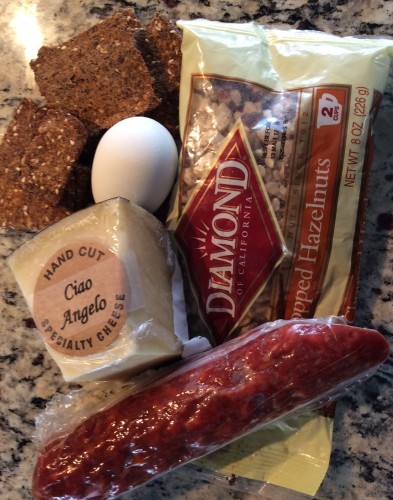I came from a strict European background where children were simply not allowed to have food preferences. I had to eat what was put in front of me: scrambled eggs with calves’ brains (yes, really), organ meats, and ethnic Czech meals with unspellable names.
As a result, when I became a travel writer, I had a huge advantage: I could eat virtually anything, from the spiciest Thai chili pepper to live termites in Belize.(They taste like carrots. Really.) I have to admit that I used to be pretty judgmental about travel writers who arrived on the other side of the world with a long list of dietary limitations: gluten-free, vegans, dairy-adverse, meat-phobic.
Now I’m one of them.

In 2016, I started a ketogenic diet in an attempt to lose enough weight to meets the requirements in order to go paragliding on a trip to Switzerland. 80 pounds later, I’m still on keto, with a fitter-than-ever-in-my-life body and good blood sugar numbers. My low-carb ketogenic diet means I don’t eat bread, pasta, rice, grains, potatoes, sugar, most fruit, milk, artificial sweeteners, and pretty much any kind of dessert.
Talk about a pain-in-the neck guest!
I try to be as inconspicuous as possible, but it’s hard to go unnoticed with that long a list. Once, a waiter in a Prague restaurant seemed on the verge of tears when I declined the dumplings (knedlicky) that are a national specialty. He insisted the meal wouldn’t be complete without them.
It can be challenging to travel ketogenically, especially if food is being provided for you, or if you’re making quick pit stops in gas station type mini-marts, or if the only food for miles is at a fast food joint. Even restaurant dining has challenges: bread on the table, sauces filled with sugar and flour, breaded everything.
Some keto folks take time off during travel. After all, sampling local specialties is an important part of cultural interaction. Loosening restrictions is certainly an valid option for some people. For others, especially those whose blood sugar levels are especially sensitive to diet, constant yo-yoing can be a problem. This post is for those who are committed to keto — or to minimizing the carbs they take in while on the road.
Where there is a will there usually is a way. It’s not always easy to turn down delicious local specialties — sushi, tacos, pizza, baguettes, dumplings. It’s especially not easy if hosts are pressuring you to try just a small piece. I (mostly) decline politely, and try to make it clear that this is my problem, not theirs. If it’s a health issue (and I honestly think for most of us, it is) say so; people are usually sympathetic to that.
Being prepared helps. I travel with enough of my own food that I can make do if what is being offered is something I can’t eat. I usually have a little snack before going to a dinner party, especially if I know the party will involvelots of hors d’oeuvres, most of which I won’t be able to eat. Of course, if you will be traveling in a situation where meals are provided, it’s always smart to alert hosts to your restrictions in advance. But don’t expect them to get everything right: Our way of eating is poorly understood and even the best intentioned host or waiter is likely to come to the wrong conclusions about what you can eat. This is, after all, OUR issue and our choice — and ours alone.
Here’s a list of travel-hardy foods that have worked for me. “Travel-hardy” means it carries well and doesn’t smell too much (in consideration of your fellow travelers).
Items that last for a few days:
- Cheese: Most cheese, especially dry hard cheese such as cheddar, Swiss, or Gouda, does not need refrigeration. Babybel, Laughing Cow, and string cheese are especially durable. On long-distance backpacking trips, I’ve carried cheese unrefrigerated for more than a week.
- Salami and similar dry sausage (check labels for added sugars and carb counts), Salami will last a few days without refrigeration.
- Jerky — again, check the carb count and sugar content. I make my own in a dehydrator.
- Nuts: macadamia and Brazil nuts have the lowest carb count.
- Pumpkin seeds.
- Pork rinds (honestly, not my favorite for travel, but they are readily available in Latin America and in convenience stores.)
- Flaxseed crackers. (Homemade; here’s a recipe.)
- Olives (although you’ll need a toothpick to spear them with so you don’t get oil all over your fingers)
- Canned foods such as spam (if you eat it), paté, sardines, or tuna fish. Some foods that used to only be available in cans now come packaged in lightweight plastic pouches. Just don’t pull out smelly foods on a plane! I’d save foods that fail the smell test for eating in your hotel room or the privacy of your car.
- Nut butters.
- Low-carb tortillas or bread. I’m not a big fan of these — Most contain some grains, and I’m suspicious about the funny math used to come up with too-good-to-be-true carb counts. But if you have any flexibility, these can be big problem solvers: they make it possible to eat those nut butters without a mess.
- Cheese chips. There’s a growing collection of low-carb snacks. Just check carb counts and portion sizes first: Calling something “low-carb” doesn’t necessarily means it fits your definition of low-carb.
- Dark chocolate.
The following items travel well for a short while, but after that, they need refrigeration:
- Boiled eggs. Some stores now carry them packaged. They still need refrigeration — but at least you can buy one or two at a time. Some people object to the smell.
- Cold ham (unsweetened) or roast beef. (I avoid other deli meats, but you could also bring cooked pieces of chicken.)
- Meat and cheese roll ups are becoming widely available in supermarkets.
- Packages of cream cheese (they can go on those flaxseed crackers).
- Julienned veggies such as celery and peppers.
- Full fat Greek yogurt.
One of the interesting and convenient things about a ketogenic diet is once you are fat adapted, your body happily chugs along burning your fat. Hunger and cravings are much less of a problem. I’ve been going on some all-day ski trips lately, and I find that cream in my coffee plus a zip lock bag full of cheese and salami plus a couple of boiled eggs lasts me though a few hours of driving and a few hours of skiing, all the way till dinner.
And if I’m hungry at the end of the day, I enjoy that dinner all the more — and revel in the likelihood that I’m continuing to lose weight.


